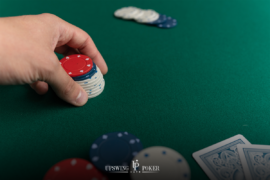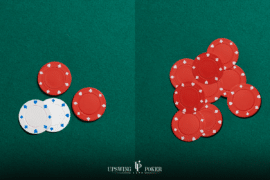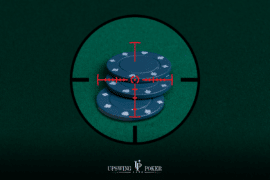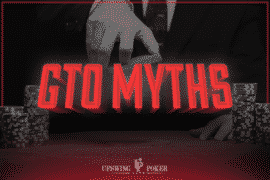
Elite Pros Battle for Chip Lead With 0 Pairs Between Them (Analysis)
When two elite players are seated together late on in a tournament, it is often wise for them to steer clear of one another. This is even more so the case if they both have big stacks.
That being said, sometimes butting heads will be unavoidable. That is what happened in the later stages of a $700 WCOOP event when high stakes pros Patrick Leonard and Nick Petrangelo woke up with some premium holdings.
In this clash of poker titans, Patrick Leonard joined myself and Dara O’Kearney for a ‘Chip Race’ strategy video. We break down his and Petrangelo’s line on every street.
Read on to find out what happened or watch the video.
Editor’s Note: This article is by Irish tournament pro and Unibet Poker ambassador David Lappin who is a great follow on Twitter. Alongside Irish poker legend Dara O’Kearney, David produces and hosts the GPI global poker award winning podcast ‘The Chip Race” sponsored by Unibet Poker. All episodes are available on Apple Music, SoundCloud and Stitcher.
Background
Game: WCOOP $700 event
Format: No Limit Hold’em, 8-Handed
Blinds: 16K/32K
Ante: 4K
Stage: In the money, 3 tables left
Relevant Stacks (Both players near the chip lead):
Leonard: 63bb
Petrangelo: 84bb
Preflop
Leonard opens UTG with A♠️ K♥️ to 2.4bb. Petrangelo 3-bets from UTG+1 to 6.7bb with K♦️ Q♦️. Leonard 4-bets to 18bb. Petrangelo calls.
Preflop Analysis
Leonard has a standard open with with A♠️ K♥️.
Similarly, Petrangelo has a standard 3-bet with K♦️ Q♦️.
Here’s where things get interesting…
At this point, Leonard has a decision to make. There are three solid options on the table: call, 4-bet to a standard size, or 4-bet all-in.
Leonard insists that Ace-King versus 3-bets is one of the most misplayed spots in tournament poker. He says that calling and shoving both have huge drawbacks when you consider how a 3-bet range versus an UTG open is constructed. High card suited and offsuit combinations will form a massive part of that range, and he is dominating of all of those.
If he just calls, he will keep in more dominated hands. However, doing so also surrenders the betting lead to a dangerous opponent who may take the pot away postflop depending on the run out. If he shoves, he will get called by no hands that he dominates while folding out very little equity.
By 4-betting to a non-all-in size, Leonard may induce a light shove from a hand like A5-suited. Plus, Petrangelo will call the 4-bet with at least a couple of dominated hands (like AQ and KQ).
Against the 4-bet, Petrangelo has a fairly borderline decision. Dara believes that calling is loose. But Leonard says that it still has some merit as he will have some bluffs in what is now a very polarized range (AA, KK, QQ and AK with hands like A9-suited or Q9-suited).
Note: Want to know how to play every hand in every common preflop situation? Get instant access to extensive preflop charts and lessons (for cash games, heads-up and tournaments) when you join the Upswing Lab training course. Lock your seat now!
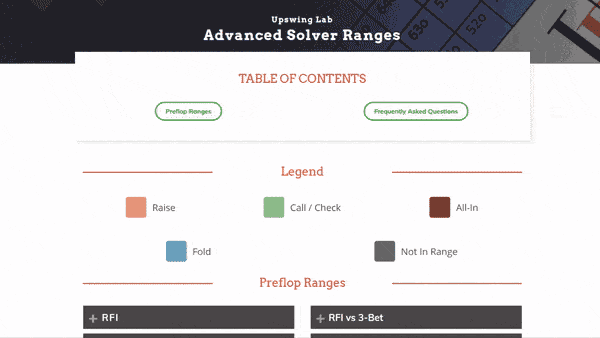
The Advanced Solver Ranges for cash games — one of five sets of preflop charts in the Upswing Lab.
Flop
The Pot: 38.8bb
The Flop: 3♦️ 2♣️ 2♠️
Stack-to-Pot Ratio: 1.15:1
The Action: Leonard bets 6.9bb (18% pot). Petrangelo calls.
Flop Analysis
Unless either player got very funky preflop with a hand like 33 or A2s, the best hand preflop will almost certainly still be good on this board.
A couple notes about the ranges at play: Leonard’s polarized range is up against the more merged range of Petrangelo, and Leonard will have the range advantage. PioSolver puts it as 55%-45%.
This means that Leonard can bet and, since the value portion of his range is super-premium hands that don’t benefit from much protection, he can choose a really small sizing.
Nick’s call seems pretty standard given that he has the backdoor flush draw with two overs and is getting an amazing price on a call, which forces him to continue with a lot of his range.
Turn
The Pot: 52.8bb
Stack-to-Pot Ratio:: 0.7:1
Board : (3♦️ 2♣️ 2♠️) J♦️
The Action: Leonard checks. Petrangelo checks.
Turn Analysis
Leonard checks and is pretty confident that Petrangelo will check back with his entire range. The reason for this is the low stack-to-pot ratio (SPR).
Leonard’s range still contains Pocket Aces and Pocket Queens when he checks, so his range is well protected.
Also, if it is Petrangelo who has slow-played a monster, he is incentivized to check as he would want the weaker part of Leonard’s range to improve. And, if Petrangelo has made a pair (like Ace-Jack or King-Jack), the stack-to-pot ratio is so low that he makes more money by slow-playing his hand.
In the unlikely scenario where Petrangelo did shove, Leonard says he would call with Ace-King.
River
The Pot: 52.8bb
Stack-to-Pot Ratio:: 0.7:1
Board: (3♦️ 2♣️ 2♠️ J♦️) 6♣️
The Action: Leonard bets 10bb (19% of pot). Petrangelo shoves for effectively 37.5bb. Leonard calls.
River Analysis
Leonard’s small bet is interesting.
Range versus range, he interprets himself as far ahead and cannot see too many calls to a shove in Petrangelo’s range. By choosing a 19% sizing, Leonard forces Petrangelo to find loose calls to prevent himself from being exploited.
Petrangelo makes an interesting decision to bluff-shove. He blocks KK and QQ, but it’s hard to say how relevant that is in this spot. Petrangelo does have to bluff some hands to balance his (relatively narrow) value range here, so it’s possible he randomized a low frequency bluff.
Having been raised, Leonard finds the call, which illustrates a second function of the bet. A 19% sizing leaves room for Petrangelo to find some bluffs to balance his slow-played monsters.
Results
Leonard calls and is shown King-high. His Ace-high takes down the 120.8bb pot.
Wrapping Up
As mentioned at the top, a clash between two top players, both with big stacks, is not a spot either relishes.
But at the end of the day, sometimes these spots can be unavoidable. And when you win these spots, it gives you a massive advantage because you can push around your opponents as the massive chip leader. When that happens, it greatly increases your chance of making a deep run.
What do you think of Leonard’s small bets on flop and river? What about Petrangelo’s river bluff?
Let me know in the comments below.
Want more tournament hand analysis? Check out Doug Polk Semi-Bluffs All-In With $3.7 Million at Stake (Analysis).
Note: Ready to join 6,000+ players currently upgrading their No Limit Hold’em skills? Crush your competition with the expert strategies you will learn inside the Upswing Lab training course. Learn more now!
